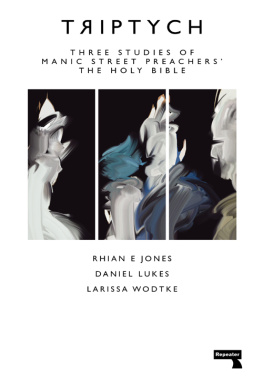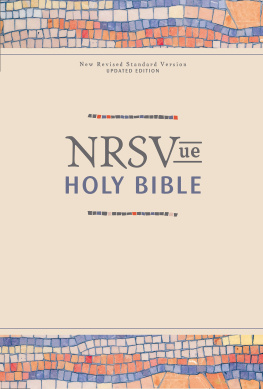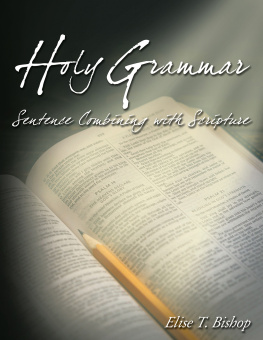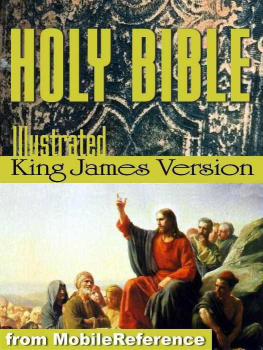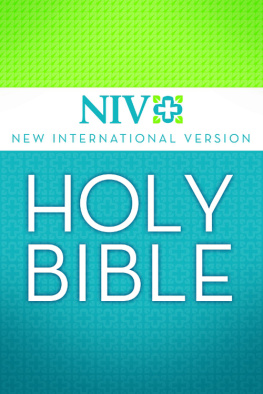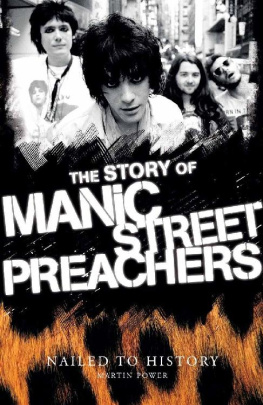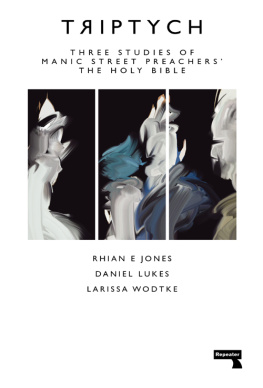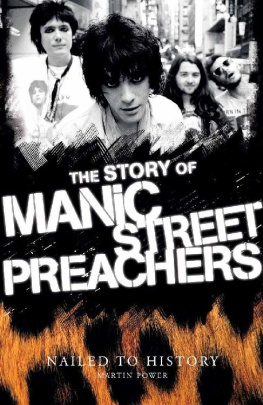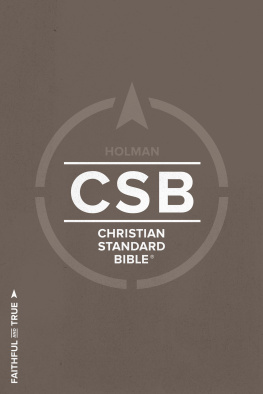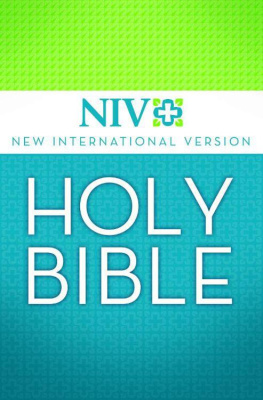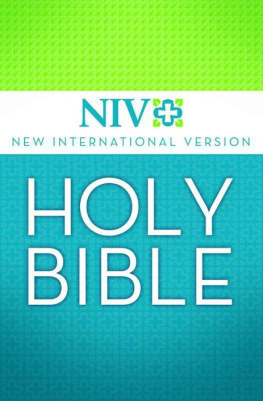Rhian E. Jones, Daniel Lukes and Larissa Wodtke
Triptych: Three Studies of Manic Street Preachers The Holy Bible
Published by Repeater Books
An imprint of Watkins Media Ltd
1921 Cecil Court
London
WC2N 4EZ
UK
www.repeaterbooks.com
A Repeater Books paperback original 2017
Copyright Rhian E. Jones, Daniel Lukes, and Larissa Wodtke 2017
Rhian E. Jones, Daniel Lukes, and Larissa Wodtke assert the moral right to be identified as the authors of this work.
Cover design: Johnny Bull
Typography and typesetting: K.DESIGN, Winscombe, Somerset
Typefaces: Chaparral Pro & AG Old Face
ISBN: 978-1-910924-98-3
Ebook ISBN: 978-1-910924-89-1
All rights reserved. No part of this publication may be reproduced, stored in a retrieval system, or transmitted, in any form or by any means, electronic, mechanical, photocopying, recording or otherwise, without the prior permission of the publishers.
This book is sold subject to the condition that it shall not, by way of trade or otherwise, be lent, re-sold, hired out or otherwise circulated without the publishers prior consent in any form of binding or cover other than that in which it is published and without a similar condition including this condition being imposed on the subsequent purchaser.
Contents
Distance and Disjuncture: Difficult Knowledge, Allegory and Irony in The Holy Bible
Body Index: Anorexia, Self-Harm and the Inability to Digest and Witness
The Pre-Emptive End of an Era
The Internal Split: The Schizophrenia and Vicissitude of Being Manic Street Preachers
Spectral Traces: Sublimated Returns
Belated and Indirect Witnessing: Memory Work and the Manics
A New Mourning, A New Translation: Making Journal for Plague Lovers
Repetition with Difference: Palimpsest and the Exhaustion of Language
This Joke Sport Severed: Journal for Plague Lovers as Missing Punchline
Manic Street Preachers are an education. No other popular artist of the last quarter-century has done more to inspire academic investigation, whether as an active catalyst (the innumerable cultural, political and historical references in the Manics lyrics and record sleeves; the much-vaunted Richey reading list) or as passive subject matter themselves (as a case study in Trojan Horse entryism; as an example of the interplay of authenticity and artifice, and so on).
My own 1999 biography, Everything (A Book About Manic Street Preachers), has itself been the topic of several theses, adding yet another layer to this sediment of meta-texts. At the time that I wrote it, I knew that mere dates and facts could never adequately convey the Manics importance, so I interrupted the narrative with a series of essays on various aspects of the band, connecting them to broader cultural themes (an approach heavily influenced by American writer Greil Marcus).
In Triptych, Rhian E. Jones, Daniel Lukes and Larissa Wodtke take that process even further, zooming in on just one album The Holy Bible with a microscopic intensity that modern rock writing rarely, if ever, attains. (Thats largely because this isnt rock writing, per se. Not in the traditional, hack sense anyway. It is academic writing of the highest calibre. By which I mean, incidentally, that among all its other qualities, it is unfailingly readable, and not prone to deliberate obfuscation.)
That The Holy Bible is the Manics masterpiece is beyond question (though one writer in Triptych does directly question that description.) It isnt only their greatest album, but one of the greatest albums ever made: I personally place it on a pedestal alongside Bowies Low and Public Enemys It Takes A Nation Of Millions To Hold Us Back.
The exact reasons for its greatness are illuminated with intimidating vividness here. Triptych (the title, of course, being a pun on The Holy Bibles tripartite cover art, South Face/Front Face/ North Face by Jenny Saville) consists of three mutually-complementary essays, each shining a searchlight onto the album from a different angle.
Rhian E. Jones, herself a product of the same South Wales mining valleys as the Manics, places the band in their correct socio-historical context, frequently (but never self-indulgently) using first-person reminiscences to illustrate her argument. As singular and jarring as The Holy Bible may have seemed in the post-political, carnivalesque Britain of 1994, Jones chapter demonstrates that it did not simply drop, unannounced and fully-formed, from a clear blue sky, nor even slate-grey one.
Daniel Lukes begins from the intriguing perspective of an outsider who failed, at first, to recognise the fellow outsiders in the Manics. He then proceeds to apply lit-crit techniques to what is, lest we forget, just a rock record, taking the Richey reading list to an extreme by venturing deep into the works of Eliot, Mirbeau, Selby, Plath and a host of others. There is, he tacitly acknowledges, a danger that immersing oneself in the Manics cultural diet is not always healthy: one section, with lovely selfawareness, is titled Reading Too Much into The Holy Bible.
Larissa Wodtkes contribution, perhaps the most poetic of the three in style, makes the case that The Holy Bible functions as a kind of aural museum (there is, one is reminded, a reason why we call such artefacts a record) that would come to define the bands every action in the decades since its release. Her deconstruction of the albums lyrics is forensic and fascinating.
Any intellectual analysis of popular music inevitably lays itself open to mockery from those who have yet to shake off the straitjacket of received notions of high and low culture. (Dare to take pop seriously as an art form and a cultural force, and an appearance in Private Eyes Pseuds Corner column is an occupational hazard.) But such concerns should be cast aside, especially when dealing with Manic Street Preachers, who reward deep thought more than any other band of their generation.
The very best music writing offers the reader hitherto-unconsidered ways of listening, and new ways of thinking about pop. Triptych achieves that, in considerable style. Its an insane book, whose very existence seems improbable and oddsdefying. The closest comparison is perhaps Invisible Republic by the aforementioned Greil Marcus, a book about just one album, The Basement Tapes by Bob Dylan (one of the few artists to inspire as much academic endeavour as the Manics). Then again, The Holy Bible is an insane, improbable, odds-defying album.
Triptych is a book I wish Id written, while knowing, deep down, that I never could. Im grateful that someone else has, or to be exact, that three other someone-elses have.
Simon Price, 2016
PART I
Unwritten Diaries: History, Politics and Experience through The Holy Bible
RHIAN E. JONES
To Kasper, Emily, Sara and Sin
CHAPTER 1
Leaving the Twentieth Century
There are parts of the country where the 90s didnt happen, they just passed in a slow iron-grey drag, and though Ive never been there I imagine Blackwood in South Wales might have been like that too. Its not poverty these places have in common, its the sulkily selfsufficient feeling of not mattering: the sing-song accents, the patches on the jackets, the dead industries, the endless guesthouses that used to be farmhouses, the metal on the radio all one side of a timeless equation of which the other is metropolitan contempt.
Next page
